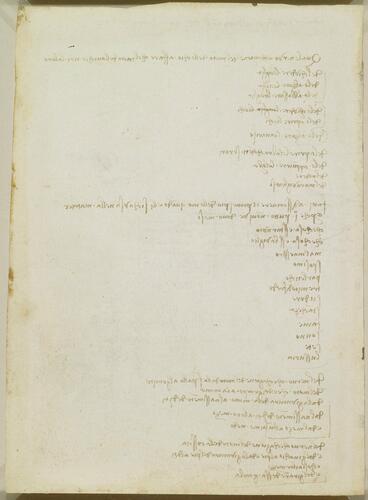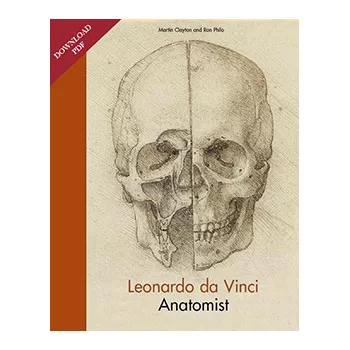Recto: The cranium. Verso: Notes on topics to be investigated 1489
Pen and ink | 18.8 x 13.9 cm (sheet of paper) | RCIN 919059
-
At the top of the sheet Leonardo wrote ‘On the 2nd day of April 1489’, adding later ‘Book entitled On the Human Figure’. With this sheet he thus began the compilation of what has been designated the ‘Anatomical Manuscript B’, a notebook of 44 folios used for anatomical studies during two periods around 1489 and 1508 (RCIN 919019-919059, 919095, and a stray sheet now in Weimar).
As an artist, Leonardo wanted to find the relationship between the brain and the body – between an individual’s emotions, expression and pose, so that he could paint a figure more convincingly. Some of his earliest anatomical studies attempt to understand the structure of the brain, the paths of the sensory nerves, and the location of the mental faculties. In April 1489 Leonardo obtained a human skull, and sectioned it to study its internal form and proportions. His grasp of three-dimensional structure is remarkable, and elsewhere he proposed an analogy between the dome of a cathedral and the cranium, which he saw as having an optimally strong design.
Indeed, it may have been the acquisition of a human skull (or skulls) that prompted Leonardo to begin his Anatomical MS B. It is difficult to determine how many skulls Leonardo had access to – the differing dentition seen in the drawings at this time (see also 919057-8) is not necessarily indicative of different specimens, for he was not simply depicting what was in front of him. Nonetheless the skull studies are exquisitely observed and modelled, and he was able to depict the nuances of the cranium using the unforgiving medium of pen and ink alone.
The drawings and accompanying note on the recto trace the path of the maxillary vein (labelled m in the upper drawing), passing under the zygomatic arch (cheekbone) and entering the orbit posteriorly, engaging the infraorbital groove and canal, and emerging through the infraorbital foramen (labelled n in the upper drawing). There it ramifies with the angular vein and other veins around the orbit. Meanwhile, the superficial temporal vein is shown coursing parallel to the maxillary vein under the zygomatic arch, then ramifying around the temple. The union of the two veins to form the retromandibular vein just below the level of the jaw is not shown.
On the verso of the sheet Leonardo listed some of the topics that he wished to investigate, in no particular order. The themes are found repeatedly in his drawings and notes at this period: facial expression, the phenomena of life, and the paths of the nerves in the limbs:
What nerve is the cause of movement of the eye and makes the movement of one eye draw the other
on closing the eyelids
on raising the eyelids
on lowering the eyelids
on shutting the eyes
on opening the eyes
on raising the nostrils
on opening the lips with the teeth closed
on bringing the lips to a point
on laughing
on [the expression of] wonder
describe the origin of man when he is generated in the womb
and why an infant of eight months does not live
what is sneezing
what is yawning
epilepsy
spasm
paralysis
trembling with cold
sweating
tiredness
hunger
sleep
thirst
lust
on the nerve which causes movement from the shoulder to the elbow
on movement from the elbow to the hand
from the wrist to the beginning of the fingers
from the beginning of the fingers to their middle
and from the middle to the last joint
on the nerve which causes movement of the thigh
and from the knee to the foot and from the ankle to the toes
and also to their middle
and of the rotation of the leg
Text adapted from M. Clayton and R. Philo, Leonardo da Vinci: Anatomist, 2012, no. 11Provenance
Bequeathed to Francesco Melzi; from whose heirs purchased by Pompeo Leoni, c.1582-90; Thomas Howard, 14th Earl of Arundel, by 1630; Probably acquired by Charles II; Royal Collection by 1690
-
Creator(s)
Acquirer(s)
-
Medium and techniques
Pen and ink
Measurements
18.8 x 13.9 cm (sheet of paper)
Other number(s)











